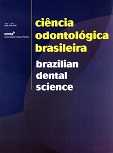Efeitos do vinagre sobre Candida Albicans aderidas in vitro em resina acrílica termicamente ativada
DOI:
https://doi.org/10.14295/bds.2008.v11i1.536Abstract
Candida albicans é um dos principais microrganismos relacionados à etiologia da estomatite por prótese. A presença da prótese com base em resina acrílica, possibilita o crescimento de leveduras tanto na prótese como na mucosa. O objetivo do presente estudo foi avaliar os efeitos de soluções de vinagre (ácido acético) sobre C. albicans aderidas, in vitro, na superfície de resina acrílica utilizada na confecção de próteses. Trinta e seis corpos-de-prova em resina acrílica termicamente ativada foram imersos em cultura de C. albicans (37oC/24 h), sendo a seguir desinfetados em solução de vinagre por 30 (n=12) e 60 min (n=12). Foram utilizadas soluções de vinagre a 10% (n=6) e 30% (n=6) e solução fisiológica 0,85% (n=6) para cada tempo de imersão. Após desinfecção, os corpos-de-prova foram lavados em solução fisiológica e a partir da solução obtida após agitação, foram realizadas diluições decimais, as quais foram semeadas em ágar Sabouraud dextrose e incubadas a 37°C/48 h. A seguir foram quantificados os log de UFC/mL de suspensão contendo microrganismos aderidos aos corpos-de-prova. Os dados foram submetidos à análise de variância ANOVA, teste de Tukey (p=0,05). Os resultados demonstraram que ocorreu redução significativa no log UFC/mL de C. albicans nos corpos-de-prova submetidos a tratamento com solução de vinagre a 10 e 30% em relação ao controle. Não ocorreu diferença significativa quando da utilização do vinagre, nos tempos de 30 e 60 minutos, para as duas concentrações do produto (10 e 30%)
Downloads
Downloads
Published
How to Cite
Issue
Section
License
Brazilian Dental Science uses the Creative Commons (CC-BY 4.0) license, thus preserving the integrity of articles in an open access environment. The journal allows the author to retain publishing rights without restrictions.
=================




























